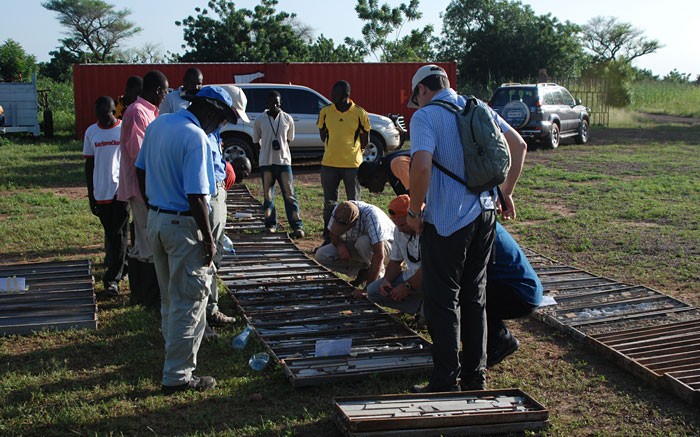Over the last year True Gold Mining (TSXV: TGM; US-OTC: RVREF) has reviewed and negotiated more than a dozen term sheets from traditional and alternative funding sources for its Karma gold project in Burkina Faso.
In the end an offer of up to US$120 million in financing from Franco-Nevada (TSX: FNV; NYSE: FNV) and Sandstorm Gold (TSX: SSL; NYSE-SAND) proved the most appealing to True Gold’s management team.
“We placed all of them [term sheets] next to each other and there was a very clear winner,” True Gold’s executive chairman Mark O’Dea told investors and analysts on a conference call.
“Bringing these two leading companies together in the first-ever syndicated deal is part of what made this transaction so appealing,” he said. “No single financing party would have been able to deliver this deal on such favourable terms.”
Under the US$100-million agreement, True Gold must deliver 100,000 oz. gold over five years — or 20,000 oz. per year starting from March 2016 — and thereafter 6.5% of the equivalent amount of gold produced at Karma for the life of the project in exchange for ongoing payments. True Gold has the option to increase the financing package by US$20 million over the next 18 months by delivering another 30,000 oz. gold on a fixed payment schedule.
The lending syndicate — split between Franco-Nevada with 75%, and Sandstorm with 25% — will pay True Gold 20% of the spot price for each ounce of gold it delivers over the five-year delivery period.
The Franco-Sandstorm funding package “stood out demonstrably as the strongest solution in terms of cost of capital, operational flexibility, alignment of business interests and long-term partnership benefits,” O’Dea said on the conference call, noting that the cost of capital is under 3%; the residual stream after year five is 6.5%, or US$16 per reserve oz. to service; and that True Gold can participate in a rising gold price environment by getting paid 20% of the spot price for every ounce of gold delivered.
“Clearly we have not given away the upside of this project or impaired its economics,” O’Dea said. “We have not over-streamed this project.”
In a research note commenting on the financing, Tara Hassan of Haywood Securities wrote: “While we are the first to admit that a stream isn’t always high on our financing preference list, the unique structure of this deal allows for an attractive cost of capital that adds to the benefits of avoiding restrictions that come with other options, such as covenants, cash sweeps and hedging at the outset of the mine. The elimination of these financial risks coupled with the increased mine planning flexibility are big benefits that can’t be reflected quantitatively.”
True Gold is on track to produce its first gold at Karma in late 2015. The company has already built the water reservoir and ordered the mining fleet, which should be on-site by December 2014. In addition, True Gold has completed detailed engineering and construction-level design work and added 1.7 million oz. inferred resources (47.8 million tonnes grading 1.08 grams gold per tonne) that were not included in the project’s feasibility study.
True Gold forecasts that Karma will produce 150,000 oz. gold in 2016 — the mine’s first full year of production.
The company is negotiating long-term consumable contracts and has started a scoping study of the North Kao deposit. Construction of major mining infrastructure will kick off in September 2014, and is expected to be completed in the third quarter of 2015, while ore from the Rambo deposit will be placed on the leach pad in the fourth quarter of 2015.
“We have taken Karma from the PEA stage to a definitive feasibility study, raised $200 million in funding and added 50% to our resource base,” O’Dea concluded. “And to achieve these milestones in one of the worst capital markets in recent history is truly noteworthy.”
Karma will be the seventh mine built in Burkina Faso since 2009.
The project in north-central Burkina Faso is 185 km northwest of the capital Ouagadougou, and consists of five gold deposits: Goulagou I, Goulagou II, Rambo, Kao and Nami.
The mine plan envisions five open pits that will be developed in sequence to feed the heap-leach operations.
The deposits are located on three of the company’s six exploration permits. True Gold owns 100% of the permits, which are subject to various royalties, including a 3% to 5% sliding scale royalty to the government of Burkina Faso.
Based on a US$1,250 per oz. gold price, the project’s feasibility study outlined a 43.1% post-tax internal rate of return and a 1.4-year payback of initial pre-production capital costs.
The project has a US$178-million post-tax net present value at a 5% discount rate.
Gold production will average 97,000 oz. per year and total 827,000 oz. over the current 8.5-year mine life.
News of the financing sent True Gold’s shares up 8% to 43¢ apiece, with 6.5 million shares traded.


Be the first to comment on "True Gold’s Karma gold mine fully funded to production"